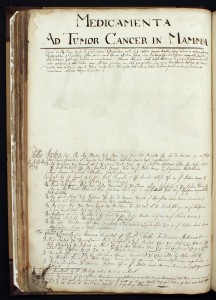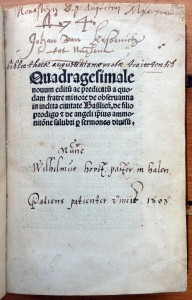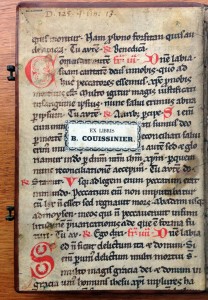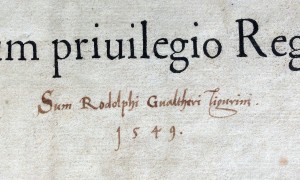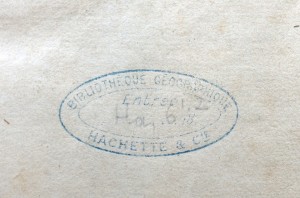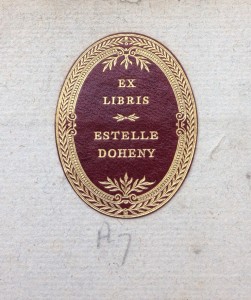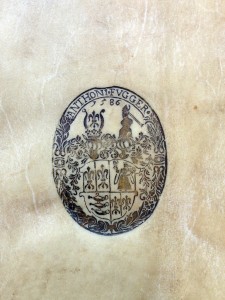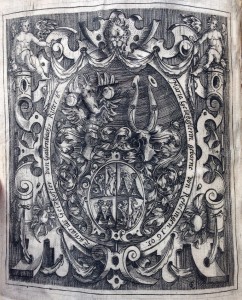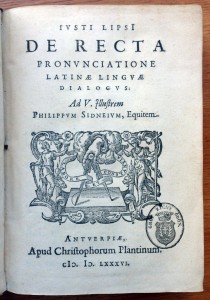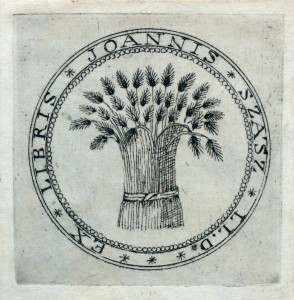While not rare book specific, I could not resist posting the fantastic news that my previous home for six and a half years has been designated a UNESCO City of Literature!
Here is the write-up by Eileen Goodwin in today's Otago Daily Times:
Dunedin has stepped on to the international literary
stage, late last night being named a Unesco Creative City of
Literature.
The designation puts the city on the world map as a
first-class literary centre, Dunedin Mayor Dave Cull said.It would help the city attract cultural tourism, tertiary
students and new residents, he said.
One of Dunedin's first steps as a City of Literature will be
to organise an international conference related to literary
culture.
Dunedin was one of four newly designated Cities of Literature
- the others were Granada, in Spain, Heidelberg, in Germany,
and Prague, in the Czech Republic.
They join existing Cities of Literature Edinburgh, Melbourne,
Iowa City, Dublin, Reykjavik, Norwich and Krakow. A country
can only have one Unesco City of Literature.
The designation showed the city was ''up there'' with other
culturally significant cities, and was not a ''colonial
outpost'', Mr Cull said.
Coming soon after the city was named the first Gigatown, the
designation was further evidence that Dunedin was moving
forward, he said.
Dunedin's application highlighted its literary heritage,
literary events, institutions and organisations, and its
community or writers, playwrights and lyricists.
''It gives us another point of difference,'' Mr Cull said.
''At a local and national level, this announcement will have
cultural and economic benefits.
''The value of having a rich culture is evidenced by events
such as this year's inaugural Dunedin Writers and Readers
Festival, which had an unexpected number of soldout events,
and attracted authors with an international profile.
''Being a City of Literature is a great brand and a very
fitting one, given that Robbie Burns' statue presides over
our central city.''
Dunedin City Council arts and culture group manager Bernie
Hawke said six of the existing Cities of Literature backed
the bid, and Dunedin was particularly grateful for the
support of its sister city, Edinburgh.
''We have been wonderfully supported internationally and
locally by writers' groups and trusts, and national writing
and publishing associations, as well as the University of
Otago.''
---
For more on Dunedin's efforts and literary city profile, see its City of Literature website and Facebook page:
http://www.cityofliterature.co.nz
https://www.facebook.com/cityofliteraturenz
Hats off to the steering committee - Liz Knowles, Noel Waite, Bernie Hawke and Annie Villiers - for all their hard work and a job well done!
02 December 2014
10 November 2014
Turnbull Library Rare Books on Tumblr
The Alexander Turnbull Library in Wellington, New Zealand, has launched a Tumblr page for its Rare Books & Fine Printing Collection:
http://turnbullrarebooks.tumblr.com
The page is off to a fun start, with topics ranging from medieval manuscripts and an eighteenth-century geometric binding, to decorative endpapers and the title-page of one of the Turnbull's copies of Aurora Australis, the first book published in Antarctica created by Ernest Shackleton.
A personal favourite is a closeup image of the pigments used on the illuminated title-page of a Persian manuscript:
If you like what you see and have a Tumblr account, do consider following and help build the library's follower base. Enjoy!
http://turnbullrarebooks.tumblr.com
The page is off to a fun start, with topics ranging from medieval manuscripts and an eighteenth-century geometric binding, to decorative endpapers and the title-page of one of the Turnbull's copies of Aurora Australis, the first book published in Antarctica created by Ernest Shackleton.
A personal favourite is a closeup image of the pigments used on the illuminated title-page of a Persian manuscript:
If you like what you see and have a Tumblr account, do consider following and help build the library's follower base. Enjoy!
24 September 2014
Memorialised in Manuscript: A Unique First World War Honour Roll
[First posted on University of Melbourne Library Collections blog]
Memorial lists recording the names of people who have died in
service to their country or local community are a tragic, but important,
part of library and institutional collections worldwide. For the First
World War alone, Special Collections holds seventeen separate registers
published between 1919 and 1926. There is, however, one further register
in the collection that was neither printed nor published, but
artfully crafted by a member of university staff.
This manuscript Honour Roll was created by Vincent J. Hearnes, who
was chief mechanic in the Department of Metallurgy workshop during the
early 1930s.[1]
According to an index card enclosed in the book, one of Hearnes’
hobbies was the production of books and decorative texts using coloured
inks he prepared. This Honour Roll is one surviving example of his work.
The book consists of 34 hand-decorated leaves recording in a calligraphic script the names of 102 graduates killed on active service between 1914 and 1918.[2] Hearnes was clearly influenced by medieval manuscript decoration and Celtic art, but added an Australian touch by using eccentrically stylised kangaroos and emus to form his knotwork patterns as exemplified in the previous images.
Rather than design decorated initials for each individual name, Hearnes instead used either one large initial for all the names on a given page, such as in the first and third of the following three examples, or incorporated multiple initials into a single design element, e.g. the combination of ‘E’, ‘F’ and ‘G’ in the middle image.
The work was also a collaborative production. The book was tastefully
bound in blue (the university colour) pebble-grained morocco with
ornamental gilt turn-ins and marbled endpapers by the prominent
Melbourne binder Harry Green. There are brief contributions by
Professors L. J. Wrigley (Department of Education) and J. Neill
Greenwood (Department of Metallurgy), and an Introduction was provided
by noted historian Professor (Sir) Ernest Scott.[3]
When and why did Hearnes compile the manuscript? Thanks to the colophon, we know he completed the Honour Roll in March 1932. The year is significant for two reasons. First, the twentieth anniversary of the outbreak of World War I was just two years away. Second, Melbourne’s war memorial, the Shrine of Remembrance, was under construction and scheduled to open in time with the anniversary in 1934.
To create a record of the Victorians who served overseas between 1914 and 1918, the committee tasked with founding and constructing the Shrine opted to have the names inscribed in a series of Books of Remembrance.[4] To ensure the longevity of the books, they sought the advice of the Victorian Arts and Crafts Society, which specified: ‘The books will be made of the best Roman Vellum, and hand bound in Levant Morocco … The binding would be done by Mr Harry Green, one of the best craftsmen in Australia in the production of Edition de Luxe. The lettering would be done by [Jason] S. Forman and assistants’.[5]
Although Hearnes’ Honour Roll was also bound by Green, he was not among Forman’s assistants, though it seems evident that their work inspired Hearnes to create a similar Book of Remembrance focused on graduates of the university.[6]
The Honour Roll was not the only calligraphic work Hearnes wished to present to the library. In a letter to the Registrar dated 5 April 1933, he wrote: ‘As I mentioned some months ago, I intended having another manuscript book finished for presentation … this year, but owing to illness … I have been unable to do any considerable amount of drawing’.[7] The letter closed with an offer of a third manuscript, one comprised of prayers written alternately in Irish and Latin. Neither book mentioned, however, is held by Special Collections.
Eight months after writing to the Registrar, Hearnes was dismissed from the university due to conflict with other staff, which, it is safe to presume, also ended any inclination on his part to donate further books.[8] This makes the Honour Roll the sole example of his calligraphic work held by the library, and a fitting object to write about, as we enter the final months of the centennial year marking the start of the First World War and prepare to commemorate the centenary of the costly Gallipoli Campaign in 2015.
 |
| Opening page. |
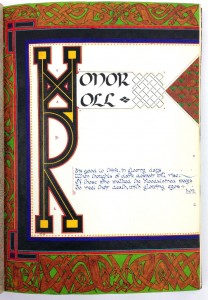 |
| Title-page. |
The book consists of 34 hand-decorated leaves recording in a calligraphic script the names of 102 graduates killed on active service between 1914 and 1918.[2] Hearnes was clearly influenced by medieval manuscript decoration and Celtic art, but added an Australian touch by using eccentrically stylised kangaroos and emus to form his knotwork patterns as exemplified in the previous images.
Rather than design decorated initials for each individual name, Hearnes instead used either one large initial for all the names on a given page, such as in the first and third of the following three examples, or incorporated multiple initials into a single design element, e.g. the combination of ‘E’, ‘F’ and ‘G’ in the middle image.
 |
| Surnames Corbett and Creswell. |
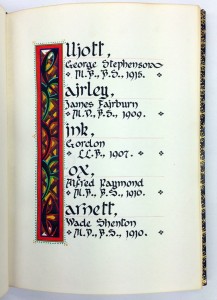 |
| Surnames Elliott to Garnett. |
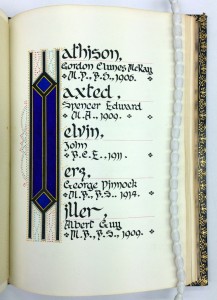 |
| Surnames Mathison to Miller. |
 |
| Professor Scott’s Introduction, 25.3.1932. |
When and why did Hearnes compile the manuscript? Thanks to the colophon, we know he completed the Honour Roll in March 1932. The year is significant for two reasons. First, the twentieth anniversary of the outbreak of World War I was just two years away. Second, Melbourne’s war memorial, the Shrine of Remembrance, was under construction and scheduled to open in time with the anniversary in 1934.
To create a record of the Victorians who served overseas between 1914 and 1918, the committee tasked with founding and constructing the Shrine opted to have the names inscribed in a series of Books of Remembrance.[4] To ensure the longevity of the books, they sought the advice of the Victorian Arts and Crafts Society, which specified: ‘The books will be made of the best Roman Vellum, and hand bound in Levant Morocco … The binding would be done by Mr Harry Green, one of the best craftsmen in Australia in the production of Edition de Luxe. The lettering would be done by [Jason] S. Forman and assistants’.[5]
Although Hearnes’ Honour Roll was also bound by Green, he was not among Forman’s assistants, though it seems evident that their work inspired Hearnes to create a similar Book of Remembrance focused on graduates of the university.[6]
The Honour Roll was not the only calligraphic work Hearnes wished to present to the library. In a letter to the Registrar dated 5 April 1933, he wrote: ‘As I mentioned some months ago, I intended having another manuscript book finished for presentation … this year, but owing to illness … I have been unable to do any considerable amount of drawing’.[7] The letter closed with an offer of a third manuscript, one comprised of prayers written alternately in Irish and Latin. Neither book mentioned, however, is held by Special Collections.
Eight months after writing to the Registrar, Hearnes was dismissed from the university due to conflict with other staff, which, it is safe to presume, also ended any inclination on his part to donate further books.[8] This makes the Honour Roll the sole example of his calligraphic work held by the library, and a fitting object to write about, as we enter the final months of the centennial year marking the start of the First World War and prepare to commemorate the centenary of the costly Gallipoli Campaign in 2015.
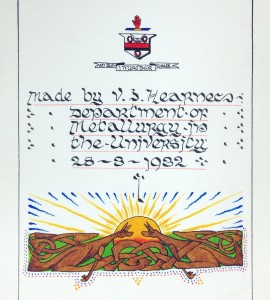 |
| Colophon dated 28.3.1932. |
[1] Essington Lewis, Development and Activities of the Metallurgy School … Melbourne: Melbourne University Press, 1935, p. 7.
[2] For the official university Roll of Honour, see The Melbourne University Magazine: War Memorial Number … Compiled by Graduates and Undergraduates of the University … Melbourne: [Printed by Ford & Son for Melbourne University Magazine], 1920.
[3] Scott was knighted in 1939. The School of Historical and Philosophical
Studies maintains a chair in his honour, and the university awards an
annual prize in Scott’s name, which was established by his widow, Lady
Emily Scott (1882–1957).
[4] The books, which number forty in total, are housed in individual bronze caskets displayed in the Ambulatory.
[5] J.B. Forman to Philip Hudson, 10 October 1929; quoted in Bruce Scates, A Place to Remember: A History of the Shrine of Remembrance.
Melbourne: Cambridge University Press, 2009, p. 129. Fine vellum proved
cost prohibitive, so parchment, cheaper but no less durable, was used.
[6] My thanks to Leigh Gilburt at the Shrine of Remembrance for confirming Hearnes was not among the calligraphers.
[7] V. J. Hearnes to the University Registrar, 5 April 1933; the letter is enclosed with the Honour Roll.
[8] File ‘H. V. [sic] Hearnes Termination of Employment’; University of
Melbourne Archives, Office of the Registrar Collection, UM 312, 1933/
206.
15 September 2014
An Apothecary’s Annotations: Eighteenth-Century Medical Notes in a Seventeenth-Century Text
[First posted on University of Melbourne Library Collections blog]
Since 2009, the rare books collection of the Brownless Medical Library has been housed by Special Collections in the Baillieu Library, University of Melbourne. This collection, which numbers 1,850 volumes, is strongest in eighteenth and nineteenth-century material. Some earlier texts are also held, such as sixteenth-century editions of the Galeni librorum quarta classis and La farmacopea o’antidotario dell’eccellentissimo Collegio de’ signori medici di Bergomo (both published in Venice, 1597) and a copy of the 1698 edition of John Browne’s Myographia nova, or, a graphical description of all the muscles in the humane body.[1]
Another seventeenth-century anatomical text in the collection is William Cowper’s The anatomy of humane bodies, printed
in Oxford for Samuel Smith and Benjamin Walford, printers to the Royal
Society, and published the same year as Browne’s 1698 Myographia nova.[2] Cowper’s book is known for its folio-sized anatomical plates by Gérard de Lairesse previously published in Govard Bidloo's Anatomia humani corporis (Amsterdam, 1685), which caused a vitriolic exchange between the two anatomists after Bidloo accused Cowper of plagiarism.[3]
What makes the Melbourne copy of Cowper’s Anatomy particularly interesting are the copious notes written between 1724 and 1740 by an English apothecary, who compiled a combination pharmacopeia and prescription book on the blank versos of sixty-two plates.
The notes refer to treatments for thirty-four diseases or groups of diseases, such as rheumatism, asthma, dysentery, pulmonary tuberculosis, and cancer. In her 2008 study of the book, Dorothea Rowse (Honorary Fellow of the School of Historical and Philosophical Studies and former Sciences Librarian) described the notes as consisting of ‘a comprehensive list of available remedies, evidence of remedies that had been used for named patients, a guide to the physicians recommended for particular medical conditions … and a record of patients who had been treated for serious medical illnesses’.[4]
The inclusion of named physicians and patients, some of whom were children, add a very real, very human element. Rowse counted fifteen physicians whose names appear in the notes, along with the names of ninety-three identifiable patients who lived in the vicinity of the village of Hambledon in the county of Hampshire.[5] Her research suggests the author of the notes was Edward Hale, an apothecary and barber surgeon, resident in Hambledon from 1720, whose son (also Edward) continued the practice.[6]
All of the notes are available on the Special Collections Flickr page:[7]
https://www.flickr.com/photos/uomspecialcollections/sets/72157647386329921
Unfortunately, due to the book being rebound, some of the notes run into the inner margin. Anyone consulting them is welcome to contact Special Collections at special-collections[@]unimelb.edu.au for assistance.
Dorothea Rowse’s full account is available on-line as a PDF at the following URL:
https://www.unimelb.edu.au/culturalcollections/research/collections3/rowse.pdf
Since 2009, the rare books collection of the Brownless Medical Library has been housed by Special Collections in the Baillieu Library, University of Melbourne. This collection, which numbers 1,850 volumes, is strongest in eighteenth and nineteenth-century material. Some earlier texts are also held, such as sixteenth-century editions of the Galeni librorum quarta classis and La farmacopea o’antidotario dell’eccellentissimo Collegio de’ signori medici di Bergomo (both published in Venice, 1597) and a copy of the 1698 edition of John Browne’s Myographia nova, or, a graphical description of all the muscles in the humane body.[1]
What makes the Melbourne copy of Cowper’s Anatomy particularly interesting are the copious notes written between 1724 and 1740 by an English apothecary, who compiled a combination pharmacopeia and prescription book on the blank versos of sixty-two plates.
The notes refer to treatments for thirty-four diseases or groups of diseases, such as rheumatism, asthma, dysentery, pulmonary tuberculosis, and cancer. In her 2008 study of the book, Dorothea Rowse (Honorary Fellow of the School of Historical and Philosophical Studies and former Sciences Librarian) described the notes as consisting of ‘a comprehensive list of available remedies, evidence of remedies that had been used for named patients, a guide to the physicians recommended for particular medical conditions … and a record of patients who had been treated for serious medical illnesses’.[4]
The inclusion of named physicians and patients, some of whom were children, add a very real, very human element. Rowse counted fifteen physicians whose names appear in the notes, along with the names of ninety-three identifiable patients who lived in the vicinity of the village of Hambledon in the county of Hampshire.[5] Her research suggests the author of the notes was Edward Hale, an apothecary and barber surgeon, resident in Hambledon from 1720, whose son (also Edward) continued the practice.[6]
All of the notes are available on the Special Collections Flickr page:[7]
https://www.flickr.com/photos/uomspecialcollections/sets/72157647386329921
Unfortunately, due to the book being rebound, some of the notes run into the inner margin. Anyone consulting them is welcome to contact Special Collections at special-collections[@]unimelb.edu.au for assistance.
Dorothea Rowse’s full account is available on-line as a PDF at the following URL:
https://www.unimelb.edu.au/culturalcollections/research/collections3/rowse.pdf
[1] The Melbourne copy of Browne’s Myographia nova is
from the Chatsworth House library of William Cavendish, 1st Duke of
Devonshire (1640–1707). The text was first published in 1681.
[2] Cowper's The amatomy of humane bodies (London, 1698) purchased with funds from the estate of F. M. Meyer.
[3] Cowper mentioned neither Bidloo nor de Lairesse in his text. According to Cowper’s ODNB entry, Bidloo 'published a complaint in 1700 addressed to the Royal Society accusing Cowper of plagiarism … which included copies of letters to Cowper, most of which had gone unanswered, correspondence with his publishers, and a list of errors. The Royal Society, with some discomfort, declined to adjudicate on the matter’.
[4] Dorothea Rowse, ‘The Hampshire Apothecary’s Book: An 18th Century Medical Manuscript in the Baillieu Library’. University of Melbourne Collections issue 3 (Dec. 2008), p. 13.
[5] Ibid, p. 15.
[6] Ibid, pp. 16-17.
[7] To view the original or larger-sized images, single click on the ‘Download this photo’ icon towards the lower right, then select ‘View all sizes’ (‘Large 2048’ file size option is recommended).
[2] Cowper's The amatomy of humane bodies (London, 1698) purchased with funds from the estate of F. M. Meyer.
[3] Cowper mentioned neither Bidloo nor de Lairesse in his text. According to Cowper’s ODNB entry, Bidloo 'published a complaint in 1700 addressed to the Royal Society accusing Cowper of plagiarism … which included copies of letters to Cowper, most of which had gone unanswered, correspondence with his publishers, and a list of errors. The Royal Society, with some discomfort, declined to adjudicate on the matter’.
[4] Dorothea Rowse, ‘The Hampshire Apothecary’s Book: An 18th Century Medical Manuscript in the Baillieu Library’. University of Melbourne Collections issue 3 (Dec. 2008), p. 13.
[5] Ibid, p. 15.
[6] Ibid, pp. 16-17.
[7] To view the original or larger-sized images, single click on the ‘Download this photo’ icon towards the lower right, then select ‘View all sizes’ (‘Large 2048’ file size option is recommended).
08 September 2014
The Rothschild Prayerbook Comes to Australia
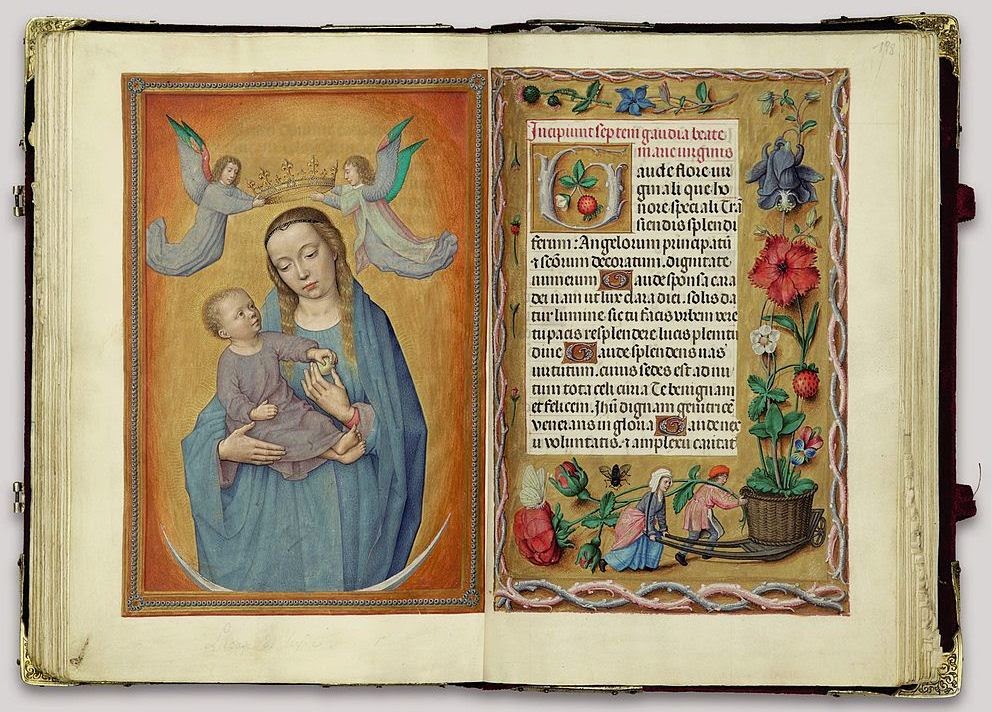 |
| Virgin and Child on a Crescent Moon, f.197v. |
News is circulating that the exquisite Rothschild Prayerbook (ca. 1505-1510), sold earlier this year by Christie's, New York, for USD $13.6m, was purchased by Australian businessman Kerry Stokes.
Mr Stokes, who also collects works of art and printed books in addition to medieval manuscripts, made his fortune in a variety of industries. His acquisition of the Rothschild Prayerbook featured yesterday on the Channel 7 'Sunday Night' programme. The segment can be viewed here:
https://au.news.yahoo.com/sunday-night/features/a/24909678/mystery-australian-buys-15m-ancient-book/
According to the programme, the manuscript will go on tour next year, with public exhibitions planned for Canberra and Melbourne.
For a description of the Prayerbook, including a number of images, see its entry in Wikipedia, or visit the Christie's on-line catalogue at the following URLs:
http://en.wikipedia.org/wiki/Rothschild_Prayerbook
http://www.christies.com/lotfinder/books-manuscripts/the-rothschild-prayerbook-a-book-of-hours-5766082-details.aspx
10 July 2014
The Gutenberg Bible on Exhibit in Melbourne
Next week sees the launch of the third annual Melbourne Rare Book Week (17 to 27 July). Bibliophiles from across Australasia and beyond will
descend upon the city and enjoy an array of talks, demonstrations and
exhibitions, ending with the Melbourne Rare Book Fair (25 to 27 July). Visitors to this year’s Rare Book Week will also be
able to attend a range of events in the university’s biennial Cultural Treasures Festival (26 and 27 July).
The university will once again host the fair in Wilson Hall, but also add something very special to the 2014 Rare Book Week programme: A 10-day exhibition of the Gutenberg Bible.
The Bible, on loan courtesy of The University of Manchester’s John Rylands Library, will be displayed from 18 to 27 July in the Dulcie Hollyock Room located on the ground floor of the Baillieu Library.
Like all Rare Book Week events, the exhibition is free and open to the public. Viewing hours are 11.00am to 5.00pm daily. Bookings not required.
A series of floor talks connected with the exhibition are also taking place. Details and how to book can be found on the Gutenberg Bible exhibition and Cultural Treasures Festival webpages.
A selection of incunabula and later religious texts from Baillieu Special Collections is also on display on the ground floor of the library in support of the Gutenberg Bible exhibit.
Whether you are local to Melbourne or just visiting, a chance to see a copy of the first substantial book printed in the Western world is not to be missed!
The university will once again host the fair in Wilson Hall, but also add something very special to the 2014 Rare Book Week programme: A 10-day exhibition of the Gutenberg Bible.
The Bible, on loan courtesy of The University of Manchester’s John Rylands Library, will be displayed from 18 to 27 July in the Dulcie Hollyock Room located on the ground floor of the Baillieu Library.
Like all Rare Book Week events, the exhibition is free and open to the public. Viewing hours are 11.00am to 5.00pm daily. Bookings not required.
A series of floor talks connected with the exhibition are also taking place. Details and how to book can be found on the Gutenberg Bible exhibition and Cultural Treasures Festival webpages.
A selection of incunabula and later religious texts from Baillieu Special Collections is also on display on the ground floor of the library in support of the Gutenberg Bible exhibit.
Whether you are local to Melbourne or just visiting, a chance to see a copy of the first substantial book printed in the Western world is not to be missed!
21 June 2014
Warburg Institute: library saved from Nazis awaits its fate
[Originally posted on the Centre for Material Texts bog]
The Times Higher Education Supplement reports that the Warburg Institute library is under threat again, as the University of London heads off to court to contest the terms of a deed of trust made in 1944.
Anyone who has worked in the library, based in the Institute’s building in Woburn Square, will know how special it is. With vast amounts of material, much of it available nowhere else in the UK, and instantly accessible on open shelves, it’s a goldmine for scholar working on the history of European art and literature.
The Warburg apparently runs a £500,000 annual deficit–which is presumably small change for an institution of the size of the University of London. Let’s hope that the administrators can be made to see sense.
09 June 2014
Australasian Rare Books Summer School 2015
The 10th anniversary Australasian Rare Books Summer School will be held 26-30 January 2015 in Wellington, New Zealand. The event is hosted by Victoria University of Wellington and the Alexander Turnbull Library, National Library of New Zealand.
Three exciting courses are on offer, each of which runs for five full days:
History of Cartography/Maps
Tutor: Julie-Sweetkind Singer, Stanford University, USA
Geographic Information Systems for Digital Humanities
Tutor: Ian Gregory, Lancaster University, UK
Artistic Printing
Tutors: Marty Vreede, Quay School of the Arts, Whanganui and Sydney Shep, Wai-te-ata Press, Victoria University of Wellington
Follow the links above for full course descriptions and instructor bios.
The cost of each course is NZD $800 + gst per person. Places are strictly limited.
For more details about RBSS 2015 visit: http://wtap.vuw.ac.nz/wordpress/digital-history/events/rare-books-summer-school/
If you would like to attend, please use the Expression of Interest on-line form, and a member of the RBSS team will contact you with more information.
Three exciting courses are on offer, each of which runs for five full days:
History of Cartography/Maps
Tutor: Julie-Sweetkind Singer, Stanford University, USA
Geographic Information Systems for Digital Humanities
Tutor: Ian Gregory, Lancaster University, UK
Artistic Printing
Tutors: Marty Vreede, Quay School of the Arts, Whanganui and Sydney Shep, Wai-te-ata Press, Victoria University of Wellington
Follow the links above for full course descriptions and instructor bios.
The cost of each course is NZD $800 + gst per person. Places are strictly limited.
For more details about RBSS 2015 visit: http://wtap.vuw.ac.nz/wordpress/digital-history/events/rare-books-summer-school/
If you would like to attend, please use the Expression of Interest on-line form, and a member of the RBSS team will contact you with more information.
Hope to see you there!
23 May 2014
Provenance in Pictures: Tracking the Ownership of Three Early Printed Books
[First posted on University of Melbourne Library Collections blog]
Last week a group of Melbourne bibliophiles were treated to a delightful talk by preeminent bookman Nicolas Barker, editor of The Book Collector since 1965, and whose bibliography records an impressive 1,000+ entries.[1]
Barker examined twenty or so works from Special Collections and talked to the salient points of each book. This post highlights three of the selected items that had multiple signs of ownership, all of which caught Barker’s eye.
1. Johannes Meder, Quadragesimale de filio prodigo et de angeli ipsius ammonitione salubri per sermones diuisum [Basel: Michael Furter, 1495].
Judging by the number of inscriptions on the title-page, this copy of Meder’s Quadragesimale certainly travelled, but not very far. All of them can be localised to the province of Limburg in the Netherlands. The earliest is the inscription by Johan van Kessenich, shown above in between two other inscriptions towards the top of the title-page. Kessenich was born ca. 1522, served as steward of the Augustinian cloister of St Elisabeth in Nunhem, and died ca. 1608. The book then passed to a Wilhelm Horst, whose tidy inscription notes that he was a pastor in the town of Haelen (just 1km south of Nunhem), and came into possession of the Quadragesimale the same year as Kessenich’s approximate date of death. The last two pieces of evidence recorded on the title-page puts the book in the library of the Augustijnenkerk (Church of the Augustinians) in Maastricht, about 55km southwest of Haelen.
The book was bound in a contemporary style by the twentieth-century French binder Roger Devauchelle (1915-1993), who preserved the original clasp catches, the paper spine label, and presumably the pastedowns: two fragments from a thirteenth-century Breviary.
Affixed to the front pastedown is the book label of ‘B. Couissinier’, and Devauchelle’s stamp can be found in the upper-left corner.[2]
Purchased by the Friends of the Baillieu Library with funds from the George Shaw Trust.
2. Eusebius Pamphilus, [Greek title:] Evangelicae praeparatio lib. XV … [with] Evangelicae demonstrationis lib. X. Paris: Robert Estienne, 1544-1545.
The earliest sign of ownership on Estienne’s 1544 edition of Eusebius is an inscription dated just five years after its publication. It reads: ‘Sum Rodolphi Gualtheri Tigurini 1549′. The owner, Rudolf Gwalther (1519-1586), was a Reformed Protestant pastor in Zurich (‘Tigurum’) who married the daughter of Huldrych Zwingli (1484-1531), one of the leaders of the Reformation in Switzerland. He became head of the Zurich church upon the death of Zwingli’s successor Heinrich Bullinger (1504-1575).
The book can next be placed in another Zurich collection, the ‘Bibliothecae Heideggeriana’. This collection was formed by Hans Heinrich Heidegger (1711-1763), whose son, Johann Heinrich (1738-1823), continued to expand the library. A slip pasted on the front free endpaper with the date ’1783′ written upon it suggests the Eusebius was acquired by the younger Heidegger that year. The Heideggeriana collection was sold in 1810 when Johann moved to Geneva.[3]
Sometime after the Heidegger sale, the Eusebius made its way to France and into the stock of the great bookshop and publishing house L. Hachette et Compagnie, whose acquisition stamp on the title-page dates to 1918.
The volume next appeared in the library of Estelle Doheny (1875-1958), who amassed one of the great twentieth-century book collections in America. Doheny left her library, which included a volume of the Gutenberg Bible, to St John’s Seminary in Camarillo, California.[4] In her bequest, Doheny stipulated that the collection must be kept together for 25 years after her death. In 1986, the Archdiocese of Los Angeles and the Seminary Board of Directors made the controversial decision to sell the Doheny collection. The books were auctioned by Christie’s, New York, in six sales held between 1987 and 1989. The Eusebius was sold to Parsons Books in the 1 February 1988 sale (lot 559).[5]
Purchased by the Ivy M. Pendlebury bequest in memory of Gerald Frederic Pendlebury.
3. De recta pronunciatione Latinae linguae dialogus. Antwerp: Christophe Plantin, 1586.
This copy of Plantin’s 1586 edition of Lipsius has a long connection to families that wielded financial power. The first being the stamp of Anton Fugger dated 1586. He was a member of a wealthy German banking and merchant family, their financial prospects secured by his namesake, Anton Fugger (1493-1560), whose trade empire extended to the Americas and the West Indies, and who also held mining interests in Scandinavia.
This beautifully engraved bookplate is the most physically impressive piece of provenance evidence found among these three books. Measuring 17 x 14 cm, the ex libris belonged to Zacharias Geizkofler von Gailenbach (1560-1617), who had his name and that of his wife, Maria (nee von Rehelingen), along with her date of birth, engraved along the central oval frame. From 1597, Geizkofler served as Reichspfennigmeister (treasurer) of the Holy Roman Empire, and as an adviser to the emperors Rudolf II (1552-1612) and Matthias (1557-1619).
The Lipsius eventually travelled to what was Austria-Hungary. There it came into the possession of the noble Magyar family, Zichy, though which family member has yet to be confirmed. The title-page is stamped with the arms and name of Count Ödön Zichy. This may refer to Count Ödön (1809-1848), a governmental administrator who was executed as a result of a court martial, or Count Ödön (1811-1894), founder of the Oriental Museum in Vienna and a great patron of art and industry.
The second Hungarian collector to own this book was Jan Szasz, about whom I have been able to find very little.[6] It appears, however, that Szasz immigrated to the Antipodes, for a number of books with his bookplate are found in Australian institutional and private libraries.
Purchased by the Ivy M. Pendlebury bequest in memory of Gerald Frederic Pendlebury.
---
---
[1] See A.S.G. Edwards, Nicolas Barker at Eighty: A List of His Publications to Mark His 80th Birthday (New Castle, DE; London: Oak Knoll Press; Bernard Quaritch Ltd., 2013).
[2] Do you recognise the ‘B. Couissinier’ bookplate? If you know who he or she was, please leave a comment or email me at Special Collections.
[3] Selecta artis typographicae monumenta e bibliotheca Heideggeriana sive Catalogus librorum seculo XV impressorum … qui pro adjectis in margine pretiis publica auctionis lege divenduntur d. 18. Jun…(Zurich, 1810)
[4] The Gutenberg Bible volume was purchased by the Maruzen Co. of Tokyo for USD $5.3m (with premium) in the 22 October 1987 sale (lot 1). It was acquired by Keio University Library in March 1996.
[5] The Estelle Doheny Collection … Part III: Printed Books and Manuscripts including Western Americana (New York: Christie, Manson & Woods, 1988) 173 (lot 559)
[6] As with the book label of M. or Mme Couissinier, I would welcome any information on this collector named Szasz.
Labels:
provenance,
University of Melbourne
04 May 2014
Original Les Miserables Manuscript on Its Way to Melbourne
[The following is from the Herald Sun website]
The original 1862 manuscript of Les Miserables — considered one of the greatest novels of the 19th century — is on its way to Melbourne.
[Exhibition] curator Tim Fisher said the “talismanic object” would be the centrepiece of the library’s forthcoming exhibition 'Victor Hugo: Les Miserables From Page to Stage', which coincides with a new production of Les Miserables premiering at Her Majesty’s Theatre.
The original 1862 manuscript of Les Miserables — considered one of the greatest novels of the 19th century — is on its way to Melbourne.
Victor Hugo’s 945-page handwritten document will leave the Bibliotheque nationale de France for the first time to be exhibited exclusively at the State Library of Victoria.
Arts Minister Heidi Victoria said the loan to Melbourne was an act of enormous trust and generosity by the French people.
“It is also significant that the State Library of Victoria is the first institution that France has entrusted this great work to,” she said.
 |
| Victor Hugo’s handwritten manuscript. Source: Supplied |
“Victor Hugo had this amazing way of writing, where he would write down one side of the page and then sometimes, years later, go back and make corrections or additions,” Mr Fisher said. “It’s not a neat object; it is full of humanity.”
Victor Hugo started working on Les Miserables in 1845, completing it 17 years later in Guernsey, where he had been living in exile after declaring Napoleon III a traitor to France.
Les Miserables has been translated into 20 languages, reprinted at least 248 times, been adapted for cinema at least 50 times, and is the foundation for three major musical adaptations.
'The Victor Hugo: Les Miserables From Page to Stage' exhibition also features the six quills Hugo used to write the manuscript, portraits of the author, photographs of scenes from various movie, theatre adaptations and comic books.
'Victor Hugo: Les Miserables From Page to Stage' opens at the State Library of Victoria on 17 July. Visit victorhugoexhibition.com.au
29 March 2014
Australia's First Banknote Sells for $334,000
[The following is from Auction Central News]
SYDNEY (AFP) – The only surviving example of Australia's first official banknote exceeded expectations when it was auctioned for AUD $334,000 (USD $310,000), officials said Thursday.
SYDNEY (AFP) – The only surviving example of Australia's first official banknote exceeded expectations when it was auctioned for AUD $334,000 (USD $310,000), officials said Thursday.
The 10 shilling note – one of 100 issued in 1817 by the Bank of New South Wales (now called Westpac) on the day it opened – attracted bids from around the world, said Jim Noble of Noble Numismatics, which handled the sale.
"It's a record for a colonial banknote," he told AFP. "It will stay in Australia (but) I've no idea what the gentleman who bought it plans to do; he's a high up executive in a big organization.”
The auction price easily exceeded its Aus$250,000 estimate, with Noble attributing the interest to its unique historical value.
"It's the only one of its kind, even Westpac does not have one," Noble said.
 |
| Australia's first banknote. Image courtesy of Noble Numismatics. |
Noble said the note was discovered in a private collection in Scotland in 2005, with Scots-born former New South Wales governor Lachlan Macquarie or one of his staff thought to have taken it there.
It was later bought by a private collector who sold it at Wednesday night's auction.
Macquarie arrived in Sydney at the end of 1809 to be confronted by a colony in crisis with no stable monetary system since the First Fleet landed in 1788.
As the new governor, he was given extensive powers to reshape the colony, but despite this his first request to London to establish a bank was rejected.
In 1812, to alleviate the shortage of currency, he imported Ł10,000 in Spanish coins from India and in 1813 manufactured and issued the "Holey Dollar" – one of which sold at auction for a world-record Aus$495,000 last year.
But it was not sufficient and in 1816 he revived his plan for a bank, this time getting London's approval, and on April 8, 1817 the Bank of New South Wales opened for business.
28 March 2014
Altering Shakespeare: An Interleaved Copy of Antony and Cleopatra
[First posted on the University of Melbourne Library Collections blog]
On 23 February 1855, the steamship Pacific docked in
Melbourne harbour. Descending the gangway for his first tour of
Australia was the Irish actor Gustavus Brooke, along with his wife
Marianne, Brooke’s leading lady Fanny Cathcart, and his stage manager
Richard W. Younge.
How Younge worked up a play for performance can been seen in his interleaved copy of Antony and Cleopatra, A Tragedy ([London?], ca. 1800), highlighted in this week’s post, along with some commentary on its provenance and use.
The inscription shown above reads ‘R. W. Younge Theatre Royal Melbourne Feby 1856′. By ‘Theatre Royal’, Younge is most likely referring to Queen’s Theatre, also known as Queen’s Theatre Royal, where Brooke’s company opened with Othello to wide acclaim, and not the Theatre Royal owned by John Black. At the time of Younge’s February 1856 inscription, Black was in direct competition with the man responsible for Brooke’s Australian tour: the entrepreneurial actor-manager George Coppin, lessee of Queen’s Theatre and owner of the prefabricated Olympic. It was not until June 1856 that Coppin took over the Theatre Royal from his then insolvent rival, and so it is highly doubtful that Younge would have infringed upon his contractual obligations by being in the Theatre Royal before then.[1]
Potential confusion about the inscription aside, what makes this copy particularly interesting are Younge’s notes and textual edits.
Not a single page of printed text escaped his pen. Younge crossed out text, jotted down stage notes, cut entire scenes, changed characters, such as Demetrius and Philo being replaced by Enobarbus and Eros at the opening of Act 1, Scene 1 (see above image), and made numerous smaller alternations throughout the play in order to adapt the text to suit the production.
Younge clearly made good use of the interleaving. His notes range from single lines to full pages of text, including many explanations and interpretation of phrases, definitions of words, musical accompaniment and stage directions, and even the occasional sketch of the set.
Despite the amount of editing and annotation, no evidence could be found that Brooke and his company ever performed Antony and Cleopatra in Australia. Contemporary newspapers record the group performing scenes from Othello, Hamlet, Richard III, Macbeth, and Merchant of Venice. According to the Dictionary of the Australian Theatre, 1788-1914, Antony and Cleopatra was not performed at Melbourne’s Theatre Royal until 1867, six years after the actors returned to England.[2]
Perhaps Brooke and Younge found the existing repertoire sufficiently successful and did not feel the need to introduce scenes from another play.[3] Regardless of the reasons why Antony and Cleopatra was not used, this copy, with its copious notes and amendments, offers a fascinating study in nineteenth-century stage production and a fine connection with a booming Melbourne during Victoria’s early gold rush years.
—
Antony and Cleopatra; A Tragedy by William Shakespeare; Accurately Printed from the Text of Mr Steeven’s Last Edition ([London?], ca. 1800); from the library of Dr John Chapman with his bookplate; purchased by the University of Melbourne from the Chapman sale, Melbourne, 24-25 February 2004 (lot 340)
[1] According to Brooke’s entry in the Australian Dictionary of Biography, when the juvenile lead Robert James Heir married Fanny Cathcart the pair left Brooke’s company for an engagement at Black’s Theatre Royal. They were brought back by a court injunction. See H. L. Oppenheim, ‘Brooke, Gustavus Vaughan (1818–1866)’, Australian Dictionary of Biography, National Centre of Biography, Australian National University, http://adb.anu.edu.au/biography/brooke-gustavus-vaughan-3064/text4519, published in hardcopy 1969, accessed online 26 March 2014.
[2] Eric Irvin, Dictionary of the Australian Theatre, 1788-1914 (Sydney: Hale & Iremonger, 1985), 28.
[3] Along with the inscription, the fact the play went unused suggests Younge bought the book in Melbourne where he had it interleaved and bound. His working up of the text for a potential addition of Antony and Cleopatra to an already full programme seems more probable after the company’s arrival in Australia than having such plans in place at the start of the tour and then dropping them (My thanks to Ian Morrison, who was Curator of Special Collections at the University of Melbourne when this book was acquired, for discussing its provenance and history with me).
How Younge worked up a play for performance can been seen in his interleaved copy of Antony and Cleopatra, A Tragedy ([London?], ca. 1800), highlighted in this week’s post, along with some commentary on its provenance and use.
 |
| Half-title inscribed by Richard W. Younge |
The inscription shown above reads ‘R. W. Younge Theatre Royal Melbourne Feby 1856′. By ‘Theatre Royal’, Younge is most likely referring to Queen’s Theatre, also known as Queen’s Theatre Royal, where Brooke’s company opened with Othello to wide acclaim, and not the Theatre Royal owned by John Black. At the time of Younge’s February 1856 inscription, Black was in direct competition with the man responsible for Brooke’s Australian tour: the entrepreneurial actor-manager George Coppin, lessee of Queen’s Theatre and owner of the prefabricated Olympic. It was not until June 1856 that Coppin took over the Theatre Royal from his then insolvent rival, and so it is highly doubtful that Younge would have infringed upon his contractual obligations by being in the Theatre Royal before then.[1]
Potential confusion about the inscription aside, what makes this copy particularly interesting are Younge’s notes and textual edits.
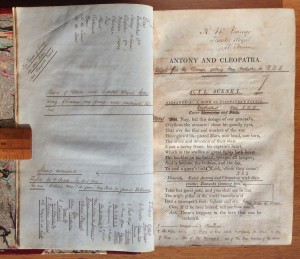 |
| Opening scene of play with annotations, notes, and a second inscription by Younge (p. [1]) |
Not a single page of printed text escaped his pen. Younge crossed out text, jotted down stage notes, cut entire scenes, changed characters, such as Demetrius and Philo being replaced by Enobarbus and Eros at the opening of Act 1, Scene 1 (see above image), and made numerous smaller alternations throughout the play in order to adapt the text to suit the production.
 |
| Younge’s changes to Act 2, Scene 2, with a further inscription (p. 26) |
Younge clearly made good use of the interleaving. His notes range from single lines to full pages of text, including many explanations and interpretation of phrases, definitions of words, musical accompaniment and stage directions, and even the occasional sketch of the set.
 |
| Sketch of set with stage notes (p. 50) |
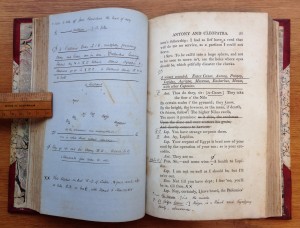 |
| Further stage notes (p. 51) |
Despite the amount of editing and annotation, no evidence could be found that Brooke and his company ever performed Antony and Cleopatra in Australia. Contemporary newspapers record the group performing scenes from Othello, Hamlet, Richard III, Macbeth, and Merchant of Venice. According to the Dictionary of the Australian Theatre, 1788-1914, Antony and Cleopatra was not performed at Melbourne’s Theatre Royal until 1867, six years after the actors returned to England.[2]
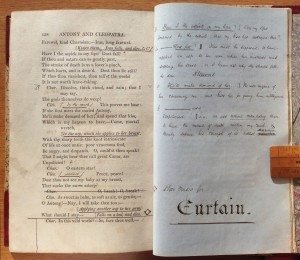 |
| Final pages (p. 141). |
Perhaps Brooke and Younge found the existing repertoire sufficiently successful and did not feel the need to introduce scenes from another play.[3] Regardless of the reasons why Antony and Cleopatra was not used, this copy, with its copious notes and amendments, offers a fascinating study in nineteenth-century stage production and a fine connection with a booming Melbourne during Victoria’s early gold rush years.
Antony and Cleopatra; A Tragedy by William Shakespeare; Accurately Printed from the Text of Mr Steeven’s Last Edition ([London?], ca. 1800); from the library of Dr John Chapman with his bookplate; purchased by the University of Melbourne from the Chapman sale, Melbourne, 24-25 February 2004 (lot 340)
[1] According to Brooke’s entry in the Australian Dictionary of Biography, when the juvenile lead Robert James Heir married Fanny Cathcart the pair left Brooke’s company for an engagement at Black’s Theatre Royal. They were brought back by a court injunction. See H. L. Oppenheim, ‘Brooke, Gustavus Vaughan (1818–1866)’, Australian Dictionary of Biography, National Centre of Biography, Australian National University, http://adb.anu.edu.au/biography/brooke-gustavus-vaughan-3064/text4519, published in hardcopy 1969, accessed online 26 March 2014.
[2] Eric Irvin, Dictionary of the Australian Theatre, 1788-1914 (Sydney: Hale & Iremonger, 1985), 28.
[3] Along with the inscription, the fact the play went unused suggests Younge bought the book in Melbourne where he had it interleaved and bound. His working up of the text for a potential addition of Antony and Cleopatra to an already full programme seems more probable after the company’s arrival in Australia than having such plans in place at the start of the tour and then dropping them (My thanks to Ian Morrison, who was Curator of Special Collections at the University of Melbourne when this book was acquired, for discussing its provenance and history with me).
14 March 2014
Vive le Roi! Richer-Sérisy's Journal L'Accusateur Public
[First posted on the University of Melbourne Library Collections blog]
University of Melbourne Special Collections recently acquired a complete set of one of the most influential French counter-revolutionary journals: L’Accusateur public. Only a few issues are available on-line through Gallica (the digital library of the Bibliothèque nationale de France), and the only other recorded set in the country is held by the National Library of Australia, making the Melbourne copy a valuable resource for students and scholars, and a fine addition to our holdings of material on the French Revolution.
L'Accusateur public was founded by the Jean Thomas Élisabeth Richer-Sérisy (1759–1803) shortly after his release from prison on 27 September 1794. Printed in Paris by Mathieu Migneret, the journal ran for thirty-five numbered issues until 1797 and brought Richer-Sérisy considerable popularity as a public writer.[1]
Such notoriety of course did not go unnoticed by Revolutionary factions, nor did the fact that Richer-Sérisy's energetic and vehement writing barely hid his Royalist opinions. His L'Accusateur public even outsold some of the pro-revolutionary periodicals, such as the Journal universal.[2] The year after The Directory seized power in the Coup of 18 Fructidor an V (4 September 1797), Richer-Sérisy was sentenced to deportation to Cayenne, French Guiana. He escaped and eventually made his way to England where he spent his remaining years. The last issue he edited (No. 35), dated 1 Frimaire an VII (21 November 1798), was seized by the police.
The acquisition also included the two unnumbered issues that appeared after No. 35.[3] The first is dated 6 Thermidor an VII (24 July 1799). Unlike the numbered series, Richer-Sérisy's name is nowhere to be found, since he had already fled from France. According to Brunet's Manuel du libraire ... (Paris, 1860-1865 ed.), the issue was instead edited by the pro-royalist general Louis Michel Auguste Thévenet Danican (1764-1848).[4]
Perhaps without Richer-Sérisy's name the issue failed to sell widely, for when a single issue of a second series appeared, possibly edited by Danican, it closed with a reprinted letter by Richer-Sérisy dated 'Berlin, 10 Mai 1799'. Richer-Sérisy, however, upon reading or hearing about the issue, declared it a forgery.[5] Its editor(s) presumably used his name as an attempt to give the new series credibility and popular appeal.
A final point about the Melbourne copy not mentioned in the sale catalogue. On the recto of the first issue half-title is a rather worn ownership stamp, that of the Comte Joseph-François de Kergariou (1779-1849), bibliophile, prefect of Indre-et-Loire, and Napoleon's chamberlain.
[1] Although
the final issue is numbered '35' there are actually thirty-four volumes
in total. Issue No. 13, which was to contain an account of the battle
between Revolutionary and Royalist forces in the streets of Paris on 13
Vendémiaire an IV (5 October 1795), was never published (perhaps not
even Richer-Sérisy could spin the Royalist's defeat). For more on its
printer, Migneret, see Carla Hesse's Publishing and Cultural Politics in Revolutionary Paris, 1789-1810 (Berkeley: University of California Press, 1991) available on-line through the UC Press E-Books Collection (accessed 13.3.2014)
[2] Kenneth Margerison, 'P.-L. Roederer: Political Thought and Practice During the French Revolution' in Transactions of the American Philosophical Society 1:1 (1983): 117
[3] The two unnumbered issues appear to be quite scarce. I was able to locate just three copies worldwide of the issue dated 6 Thermidor an VII and only two copies of the second series issue. No other copies are recorded in other Australian institutions.
[4] Charles Brunet, Manuel du libraire et de l'amateur de livres ... 6 vols. (Paris: Firmin Didot frères, fils et Cie, 1860-1865), 6:1869-1870
[5] University of Pennsylvania Libraries catalogue: http://www.franklin.library.upenn.edu/record.html?id=FRANKLIN_13561 [No citation given regarding the forgery comment]
University of Melbourne Special Collections recently acquired a complete set of one of the most influential French counter-revolutionary journals: L’Accusateur public. Only a few issues are available on-line through Gallica (the digital library of the Bibliothèque nationale de France), and the only other recorded set in the country is held by the National Library of Australia, making the Melbourne copy a valuable resource for students and scholars, and a fine addition to our holdings of material on the French Revolution.
 |
| First issue, p. 1 |
L'Accusateur public was founded by the Jean Thomas Élisabeth Richer-Sérisy (1759–1803) shortly after his release from prison on 27 September 1794. Printed in Paris by Mathieu Migneret, the journal ran for thirty-five numbered issues until 1797 and brought Richer-Sérisy considerable popularity as a public writer.[1]
Such notoriety of course did not go unnoticed by Revolutionary factions, nor did the fact that Richer-Sérisy's energetic and vehement writing barely hid his Royalist opinions. His L'Accusateur public even outsold some of the pro-revolutionary periodicals, such as the Journal universal.[2] The year after The Directory seized power in the Coup of 18 Fructidor an V (4 September 1797), Richer-Sérisy was sentenced to deportation to Cayenne, French Guiana. He escaped and eventually made his way to England where he spent his remaining years. The last issue he edited (No. 35), dated 1 Frimaire an VII (21 November 1798), was seized by the police.
 | |||
| Cartoon of the pro-Directory 'Constitutional Circle' known as the Club de Salm |
The acquisition also included the two unnumbered issues that appeared after No. 35.[3] The first is dated 6 Thermidor an VII (24 July 1799). Unlike the numbered series, Richer-Sérisy's name is nowhere to be found, since he had already fled from France. According to Brunet's Manuel du libraire ... (Paris, 1860-1865 ed.), the issue was instead edited by the pro-royalist general Louis Michel Auguste Thévenet Danican (1764-1848).[4]
Perhaps without Richer-Sérisy's name the issue failed to sell widely, for when a single issue of a second series appeared, possibly edited by Danican, it closed with a reprinted letter by Richer-Sérisy dated 'Berlin, 10 Mai 1799'. Richer-Sérisy, however, upon reading or hearing about the issue, declared it a forgery.[5] Its editor(s) presumably used his name as an attempt to give the new series credibility and popular appeal.
 |
| The supposed Richer-Serisy letter, 10 May 1799 |
A final point about the Melbourne copy not mentioned in the sale catalogue. On the recto of the first issue half-title is a rather worn ownership stamp, that of the Comte Joseph-François de Kergariou (1779-1849), bibliophile, prefect of Indre-et-Loire, and Napoleon's chamberlain.
----
[2] Kenneth Margerison, 'P.-L. Roederer: Political Thought and Practice During the French Revolution' in Transactions of the American Philosophical Society 1:1 (1983): 117
[3] The two unnumbered issues appear to be quite scarce. I was able to locate just three copies worldwide of the issue dated 6 Thermidor an VII and only two copies of the second series issue. No other copies are recorded in other Australian institutions.
[4] Charles Brunet, Manuel du libraire et de l'amateur de livres ... 6 vols. (Paris: Firmin Didot frères, fils et Cie, 1860-1865), 6:1869-1870
[5] University of Pennsylvania Libraries catalogue: http://www.franklin.library.upenn.edu/record.html?id=FRANKLIN_13561 [No citation given regarding the forgery comment]
28 February 2014
ANZAAB Conference and Melbourne Rare Book Week
The following was posted on the ANZAAB website.
Conference in May
'The most agreeable servants of civilization' Booksellers and Librarians in a Changing World
A Joint Conference of the Australian and New Zealand Association of Antiquarian Booksellers (ANZAAB) and the National Library of Australia.
Discussions and presentations on how the rare book trade operates, how libraries and booksellers can work together more effectively, a 'pop up' rare book fair, a display of some National Library of Australia treasures and tailored behind the scenes tours make for two unmissable days for anyone working with and with an interest in rare books, manuscripts and photographs.
This is the first time a conference such as this has been held in Australia. This conference will give participants the chance to meet others working with or interested in rare materials on paper while at the same time hearing from some foremost scholars, librarians and antiquarian booksellers. Not to be missed!
Monday 19 May, 8.30 am - 5.30 pm & Tuesday 20 May, 9 am - 4.30 pm
Conference Room, Level 4
National Library of Australia
Complete Programme
Bookings now open
For more information contact Sally Burdon at Asia Bookroom.
----
Third Annual Melbourne Rare Book Week
ANZAAB has also recently announced the 2014 Melbourne Rare Book Week from 17 to 27 July, incorporating the 42nd ANZAAB Australian Antiquarian Book Fair from 25 to 27 July at Wilson Hall, University of Melbourne.
The following was posted on the ILAB website:
The Melbourne Rare Book Week is now well established in the City of Melbourne’s event calendar. It is a major attraction for book collectors, librarians and all who have a love of words, print on paper and heritage, and the 2014 programme promises another outstanding event.
Kay Craddock on behalf of the Melbourne Rare Book Week Committee:
"To date, we have attracted six new event partners from Melbourne’s literary community and all of the 2013 partners have rejoined the programme, making a total of 25. New partners are: The Library at the Dock (due to open in Docklands in May), Grainger Museum, The Johnson Society of Australia, Royal Australasian College of Surgeons (Cowlishaw Library), Royal United Services Institute of Victoria Library and the Victorian College of the Arts.
The City of Melbourne has pledged increased sponsorship funding and will work with us to promote our events at its new Docklands Library. We have been extraordinarily fortunate to engage the support of leading Consumer, Industry and Market Research company, Roy Morgan Research. In addition to hosting several individual events, Roy Morgan Research will be promoting the entire programme through its extensive network of marketing, media, corporate, institutional and government customers. On Monday March 17, Gary Morgan and his CEO, Michele Levine, are hosting a media/sponsorship launch of Melbourne Rare Book Week. This will be an opportunity for event partners to promote the programme and to network with prospective sponsors and journalists."
As part of the Melbourne Rare Book Week, the 42nd ANZAAB Australian Antiquarian Book Fair will be held at the University of Melbourne's historic Wilson Hall, with free admission to all visitors. The 2014 Book Fair will again be held in partnership with the biennial University of Melbourne Cultural Treasures Festival — a programme of free exhibitions, thematic walks, talks, seminars, demonstrations, displays and guided tours which showcase the University's rich array of museums and collections.
[I will post this year's events when announced. Needless to say, I cannot wait!]
Conference in May
'The most agreeable servants of civilization' Booksellers and Librarians in a Changing World
A Joint Conference of the Australian and New Zealand Association of Antiquarian Booksellers (ANZAAB) and the National Library of Australia.
Discussions and presentations on how the rare book trade operates, how libraries and booksellers can work together more effectively, a 'pop up' rare book fair, a display of some National Library of Australia treasures and tailored behind the scenes tours make for two unmissable days for anyone working with and with an interest in rare books, manuscripts and photographs.
This is the first time a conference such as this has been held in Australia. This conference will give participants the chance to meet others working with or interested in rare materials on paper while at the same time hearing from some foremost scholars, librarians and antiquarian booksellers. Not to be missed!
Monday 19 May, 8.30 am - 5.30 pm & Tuesday 20 May, 9 am - 4.30 pm
Conference Room, Level 4
National Library of Australia
Complete Programme
Bookings now open
For more information contact Sally Burdon at Asia Bookroom.
----
Third Annual Melbourne Rare Book Week
ANZAAB has also recently announced the 2014 Melbourne Rare Book Week from 17 to 27 July, incorporating the 42nd ANZAAB Australian Antiquarian Book Fair from 25 to 27 July at Wilson Hall, University of Melbourne.
The following was posted on the ILAB website:
The Melbourne Rare Book Week is now well established in the City of Melbourne’s event calendar. It is a major attraction for book collectors, librarians and all who have a love of words, print on paper and heritage, and the 2014 programme promises another outstanding event.
Kay Craddock on behalf of the Melbourne Rare Book Week Committee:
"To date, we have attracted six new event partners from Melbourne’s literary community and all of the 2013 partners have rejoined the programme, making a total of 25. New partners are: The Library at the Dock (due to open in Docklands in May), Grainger Museum, The Johnson Society of Australia, Royal Australasian College of Surgeons (Cowlishaw Library), Royal United Services Institute of Victoria Library and the Victorian College of the Arts.
The City of Melbourne has pledged increased sponsorship funding and will work with us to promote our events at its new Docklands Library. We have been extraordinarily fortunate to engage the support of leading Consumer, Industry and Market Research company, Roy Morgan Research. In addition to hosting several individual events, Roy Morgan Research will be promoting the entire programme through its extensive network of marketing, media, corporate, institutional and government customers. On Monday March 17, Gary Morgan and his CEO, Michele Levine, are hosting a media/sponsorship launch of Melbourne Rare Book Week. This will be an opportunity for event partners to promote the programme and to network with prospective sponsors and journalists."
As part of the Melbourne Rare Book Week, the 42nd ANZAAB Australian Antiquarian Book Fair will be held at the University of Melbourne's historic Wilson Hall, with free admission to all visitors. The 2014 Book Fair will again be held in partnership with the biennial University of Melbourne Cultural Treasures Festival — a programme of free exhibitions, thematic walks, talks, seminars, demonstrations, displays and guided tours which showcase the University's rich array of museums and collections.
[I will post this year's events when announced. Needless to say, I cannot wait!]
21 February 2014
Nullius in Verba: The Royal Society's Two Earliest Books
[First posted on the University of Melbourne Library Collections blog]
Earlier this week the Royal Society announced the launch later this year of Royal Society Open Science, an open access peer-reviewed journal publishing scholarly research in all fields scientific and mathematical. The move is seen by the Society’s president, Sir Paul Nurse, as a necessary step to keep pace with the changing face of publishing in the twenty-first century.
Changes in the publishing field is something the Royal Society has seen a lot of throughout its long history. The august body received a Royal Charter to publish relevant works in 1662 (two years after its official founding in November 1660), and will observe the 350th anniversary of its journal Philosophical Transactions in March 2015.
With the recent open access announcement and next year’s anniversary of Philosophical Transactions in mind, this week’s post highlights the Royal Society’s two earliest books: John Evelyn’s Sylva and Robert Hooke’s Micrographia; first editions of each are held by University of Melbourne Special Collections.[1]
Sylva
First printed in 1664, Sylva, or a Discourse of Forest-Trees and the Propagation of Timber was the first work sponsored officially by the Royal Society and the first treatise in English dedicated entirely to forestry.[2] Its author, John Evelyn (1620–1706), writer, intellectual and founding member of the Royal Society, is perhaps best known for his long-running diary kept from 1640 to 1706.
Evelyn initially presented Sylva as a paper to the Royal Society in 1662. The published text sought to encourage tree-planting after the destruction wrought by the Civil War and, it has been argued, to ensure a supply of timber for England’s developing navy and add a further boost to the economy. Evelyn’s book proved highly popular with its intended audience, namely the gentry and aristocracy, who took from it the idea of gardening as an aesthetic pursuit, and his discourse was positively received on the Continent where it stimulated new methods of forest management.[3] Today Sylva is recognised as one of the most influential works on the subject of tree conservation.
The first edition of Sylva contained two appendixes: Pomona: or, an Appendix Concerning Fruit-Trees in Relation to Cider, one of the earliest English essays on cider, and the Kalendarium Hortense: or, Gard’ners Almanac: Directing What He is To Do Monethly [sic] Throughout the Year, which was often reprinted separately and proved to be Evelyn’s most popular work.[4]
Micrographia
The second text printed for the Royal Society was Robert Hooke’s groundbreaking Micrographia, or Some Physiological Descriptions of Minute Bodies Made by Magnifying Glasses, published in 1665. Hooke (1635–1703), a natural philosopher and polymath, perfected the compound microscope and put the instrument to good use. His observations touched on a number of subjects, from combustion and diffraction of light, to fossils and artificial silk, and his description of the honeycomb-like structure of a cork gave us the word ‘cell’ to describe the basic biological unit of living organisms.
Micrographia is perhaps most widely known today for its illustrations. The book includes 57 microscopic and 3 telescopic observations, describing for the first time ‘a polyzoon, the minute markings of fish scales, the structure of the bee’s sting [and wings], the compound eyes of the fly, the gnat and its larvae, the structure of feathers, the flea and the louse’.[5] These enlarged images of such minute creatures (Hooke’s louse measures 45.7 cm in length) are as startling today as they must have been for Hooke’s contemporaries over 300 years ago.
Like Sylva, Hooke’s Micrographia was an immediate success. It was read by Samuel Pepys, who mentioned the book three times in his diary for January 1664/5 and called it ‘the most ingenious book I have ever read in my life’ (Pepys was also a member of the Royal Society).[6] The text, particularly Hooke’s observations on light and the spectrum, was also studied by Isaac Newton who drew inspiration from it for his Opticks: or, a Treatise of the Reflexions, Refractions, Inflexions and Colours of Light (London, 1704).
Robert Hooke, Micrographia, or Some Physiological Descriptions of Minute Bodies Made by Magnifying Glasses with Observations and Inquiries Thereupon (London: Printed by Jo. Martyn and Ja. Allestry, Printers to the Royal Society, [1665])
[2] Special Collections also holds copies of the 1670 second edition and 1679 third edition of Sylva, both of which were printed for the Royal Society
[3] http://royalsociety.org/events/2013/sustainability/ [Accessed 19.2.2014]
[4] Diana H. Hook and Jeremy Norman, The Haskell F. Norman Library of Science and Medicine, 2 vols. (San Francisco: Jeremy Norman & Co., Inc, 1991), i:271
[5] John Carter and Percy H. Muir, eds., Printing and the Mind of Man … (London: Cassell and Company Ltd., 1967 ed.), 88 (no. 147)
[6] Robert Latham and William Matthews, eds., The Diary of Samuel Pepys … 11 vols. (London: G. Bell and Sons Ltd, 1970-1976), vi:2, 17, 18
Earlier this week the Royal Society announced the launch later this year of Royal Society Open Science, an open access peer-reviewed journal publishing scholarly research in all fields scientific and mathematical. The move is seen by the Society’s president, Sir Paul Nurse, as a necessary step to keep pace with the changing face of publishing in the twenty-first century.
Changes in the publishing field is something the Royal Society has seen a lot of throughout its long history. The august body received a Royal Charter to publish relevant works in 1662 (two years after its official founding in November 1660), and will observe the 350th anniversary of its journal Philosophical Transactions in March 2015.
With the recent open access announcement and next year’s anniversary of Philosophical Transactions in mind, this week’s post highlights the Royal Society’s two earliest books: John Evelyn’s Sylva and Robert Hooke’s Micrographia; first editions of each are held by University of Melbourne Special Collections.[1]
Sylva
First printed in 1664, Sylva, or a Discourse of Forest-Trees and the Propagation of Timber was the first work sponsored officially by the Royal Society and the first treatise in English dedicated entirely to forestry.[2] Its author, John Evelyn (1620–1706), writer, intellectual and founding member of the Royal Society, is perhaps best known for his long-running diary kept from 1640 to 1706.
Evelyn initially presented Sylva as a paper to the Royal Society in 1662. The published text sought to encourage tree-planting after the destruction wrought by the Civil War and, it has been argued, to ensure a supply of timber for England’s developing navy and add a further boost to the economy. Evelyn’s book proved highly popular with its intended audience, namely the gentry and aristocracy, who took from it the idea of gardening as an aesthetic pursuit, and his discourse was positively received on the Continent where it stimulated new methods of forest management.[3] Today Sylva is recognised as one of the most influential works on the subject of tree conservation.
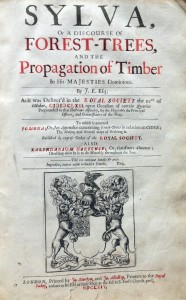 |
| First ed. title-page with the arms of the Royal Society |
The first edition of Sylva contained two appendixes: Pomona: or, an Appendix Concerning Fruit-Trees in Relation to Cider, one of the earliest English essays on cider, and the Kalendarium Hortense: or, Gard’ners Almanac: Directing What He is To Do Monethly [sic] Throughout the Year, which was often reprinted separately and proved to be Evelyn’s most popular work.[4]
 |
| Title-page of Evelyn’s Kalendarium Hortense |
Micrographia
The second text printed for the Royal Society was Robert Hooke’s groundbreaking Micrographia, or Some Physiological Descriptions of Minute Bodies Made by Magnifying Glasses, published in 1665. Hooke (1635–1703), a natural philosopher and polymath, perfected the compound microscope and put the instrument to good use. His observations touched on a number of subjects, from combustion and diffraction of light, to fossils and artificial silk, and his description of the honeycomb-like structure of a cork gave us the word ‘cell’ to describe the basic biological unit of living organisms.
Micrographia is perhaps most widely known today for its illustrations. The book includes 57 microscopic and 3 telescopic observations, describing for the first time ‘a polyzoon, the minute markings of fish scales, the structure of the bee’s sting [and wings], the compound eyes of the fly, the gnat and its larvae, the structure of feathers, the flea and the louse’.[5] These enlarged images of such minute creatures (Hooke’s louse measures 45.7 cm in length) are as startling today as they must have been for Hooke’s contemporaries over 300 years ago.
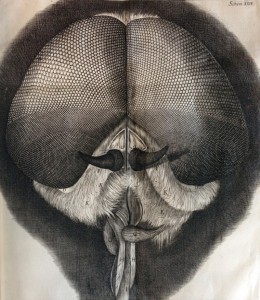 |
| Compound eye of the fly (Schema 24) |
 |
| A flea (Schema 34) |
 |
| A louse (Schema 35) |
Like Sylva, Hooke’s Micrographia was an immediate success. It was read by Samuel Pepys, who mentioned the book three times in his diary for January 1664/5 and called it ‘the most ingenious book I have ever read in my life’ (Pepys was also a member of the Royal Society).[6] The text, particularly Hooke’s observations on light and the spectrum, was also studied by Isaac Newton who drew inspiration from it for his Opticks: or, a Treatise of the Reflexions, Refractions, Inflexions and Colours of Light (London, 1704).
—
[1] John Evelyn, Sylva, or a Discourse of Forest-Trees and the Propagation of Timber
(London: Printed by Jo. Martyn and Ja. Allestry, Printers to the Royal
Society, [1664]); purchased by the Friends of the Baillieu LibraryRobert Hooke, Micrographia, or Some Physiological Descriptions of Minute Bodies Made by Magnifying Glasses with Observations and Inquiries Thereupon (London: Printed by Jo. Martyn and Ja. Allestry, Printers to the Royal Society, [1665])
[2] Special Collections also holds copies of the 1670 second edition and 1679 third edition of Sylva, both of which were printed for the Royal Society
[3] http://royalsociety.org/events/2013/sustainability/ [Accessed 19.2.2014]
[4] Diana H. Hook and Jeremy Norman, The Haskell F. Norman Library of Science and Medicine, 2 vols. (San Francisco: Jeremy Norman & Co., Inc, 1991), i:271
[5] John Carter and Percy H. Muir, eds., Printing and the Mind of Man … (London: Cassell and Company Ltd., 1967 ed.), 88 (no. 147)
[6] Robert Latham and William Matthews, eds., The Diary of Samuel Pepys … 11 vols. (London: G. Bell and Sons Ltd, 1970-1976), vi:2, 17, 18
Subscribe to:
Posts (Atom)



